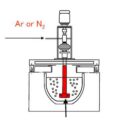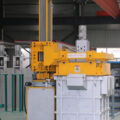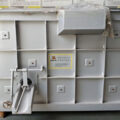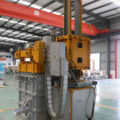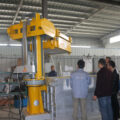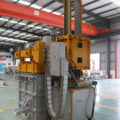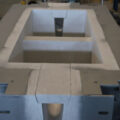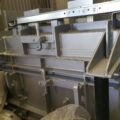The aluminum degassing device can realize the continuous degassing of the aluminum melt, improve the quality of the product, and does not affect the production process. The degassing unit is composed of box body, box cover, heating system, pore system, and refining system. It can effectively remove hydrogen, alkali metals, and other impurities in the aluminum melt.
The material of degassing device, heater protection sleeve, and thermocouple are all silicon nitride materials. With a unique internal doping flow design, a good and stable degassing effect can be guaranteed. According to the processing capacity The equipment can be divided into single-chamber single-rotor, double-chamber double-rotor (2B2R), and three-chamber three-rotor.
The aluminum degassing device mainly processes molten aluminum containing a certain amount of hydrogen and other residues (alkali metals, slag inclusions), which are removed after degassing. The processing principle is gas flotation, and the process gas (inert gas or mixture gas) is injected into the melt through the rotor and broken into evenly dispersed tiny bubbles. The tiny bubbles rise to the surface of the melt. The following tasks are completed during the rise of the tiny bubbles: hydrogen is absorbed into the bubbles and eliminated; Alkali metals are removed by chemical interaction with chlorine gas (chloride formation); inclusions are trapped by bubbles and then rise to the surface of the melt to form dross.

Instructions for Degassing Equipment
When the oven is finished, the heating element is turned off before the molten aluminum enters the box. When the temperature of the heater is close to that of the molten aluminum, inert gas is introduced into the rotor, and then the molten aluminum is filled into the box.
In order to observe the molten aluminum entering the tank, the filling operation was stopped at a position about 3 cm from the bottom of the launder.
The box cover is closed (the box has a slag raking port). When the metal flows into the box, scum is generated. The slag on the metal surface can be skimmed through the slagging port.
It is recommended that the temperature rises to above 780 degrees to reproduce, start the temperature holding stage, and close the slagging port.
During the heat preservation phase, the molten aluminum between castings is allowed to remain in the box at the temperature set by the operator, and the molten aluminum is not processed in this heat preservation phase.
A small amount of inert gas needs to be introduced into the rotor to prevent molten aluminum from entering the rotor and blocking the rotor vents.
After the molten metal stops filling operation, the heater needs to be started immediately, and the heating is controlled according to the metal insulation parameters, which is set by the operator.
By starting the heating system to control the temperature of the molten aluminum, it is necessary to monitor the gas flow rate, the rotor speed increases, and the speed is changed from the holding stage to the set speed in the processing stage, and the inert gas flow into the rotor increases, from the holding stage to the processing stage flow.
The operator sets the temperature of the molten aluminum in the processing stage and heats in this mode to achieve a stable degassing working state.



